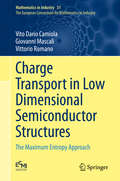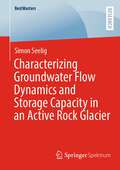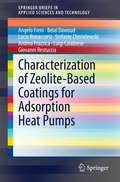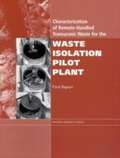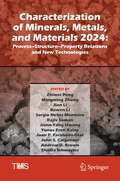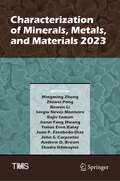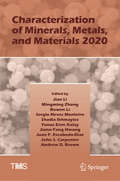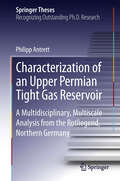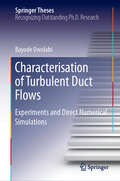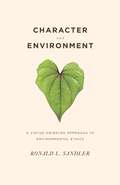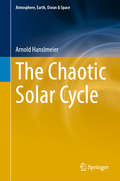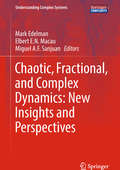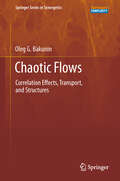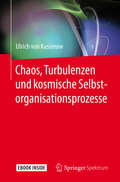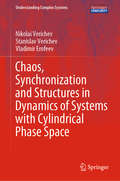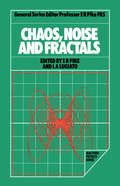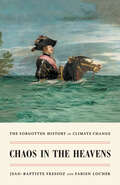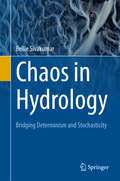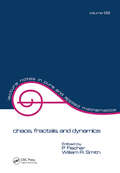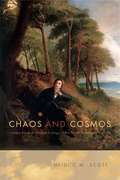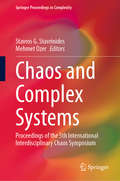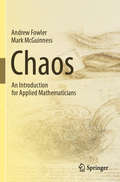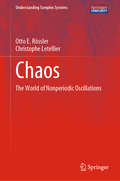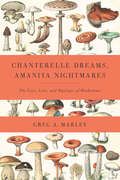- Table View
- List View
Charge Transport in Low Dimensional Semiconductor Structures: The Maximum Entropy Approach (Mathematics in Industry #31)
by Vittorio Romano Vito Dario Camiola Giovanni MascaliThis book offers, from both a theoretical and a computational perspective, an analysis of macroscopic mathematical models for description of charge transport in electronic devices, in particular in the presence of confining effects, such as in the double gate MOSFET. The models are derived from the semiclassical Boltzmann equation by means of the moment method and are closed by resorting to the maximum entropy principle. In the case of confinement, electrons are treated as waves in the confining direction by solving a one-dimensional Schrödinger equation obtaining subbands, while the longitudinal transport of subband electrons is described semiclassically. Limiting energy-transport and drift-diffusion models are also obtained by using suitable scaling procedures. An entire chapter in the book is dedicated to a promising new material like graphene. The models appear to be sound and sufficiently accurate for systematic use in computer-aided design simulators for complex electron devices. The book is addressed to applied mathematicians, physicists, and electronic engineers. It is written for graduate or PhD readers but the opening chapter contains a modicum of semiconductor physics, making it self-consistent and useful also for undergraduate students.
Characterizing Groundwater Flow Dynamics and Storage Capacity in an Active Rock Glacier (BestMasters)
by Simon KainzAlpine aquifers play a critical role in the hydrology of mountainous areas by sustaining base flow in downstream rivers during dry periods and retarding flood propagation after heavy precipitation events. Progressing climate change alters climatic and meteorological boundary conditions as well as the hydraulic response of alpine catchments by ablating glaciers and thawing permafrost. Rock glaciers exert a controlling influence on the catchment response due to their prominent groundwater storage and complex drainage characteristics. This thesis investigates the hydrogeology and internal structure of the active rock glacier Innere Ölgrube (Ötztal Alps), which governs catchment runoff and is affected by permafrost degradation. A 3D geometrical model of its internal structure is obtained by combining geophysical data and permafrost creep modelling. Available data and new results are integrated into a conceptual hydrogeological model providing a sound basis for the implementation of a prospective numerical groundwater flow model. Hydraulic properties of the hydrostratigraphic units constituting the rock glacier are estimated and groundwater recharge fluxes quantified. Fundamental properties of the heterogeneous groundwater flow system within the rock glacier are discussed and compared to existing rock glacier studies.
Characterization of Zeolite-Based Coatings for Adsorption Heat Pumps (SpringerBriefs in Applied Sciences and Technology)
by Angelo Freni Belal Dawoud Lucio Bonaccorsi Stefanie Chmielewski Andrea Frazzica Luigi Calabrese Giovanni RestucciaThis book proposes a radically new approach for characterizing thermophysical and mechanical properties of zeolite-based adsorbent coatings for Adsorptive Heat Transformers (AHT). It presents a developed standard protocol for the complete characterization of advanced coated adsorbers. Providing an in-depth analysis of the different procedures necessary for evaluating the performance of adsorbers, it also presents an analysis of their stability under the hydrothermal and mechanical stresses during their entire life cycle. Adsorptive Heat Transformers (AHT), especially adsorption chillers and heat pumps, are considered to be promising technologies to increase thermal energy efficiency. Nevertheless, an overall increase in performance of this apparatus is necessary for them to be considered a mature technology to be used commercially. Development of innovative coated adsorbers can be perceived as a key issue for the enhancement of AHT technology. This procedure relies on the deposition, either by means of a binder or by direct crystallization, of the adsorbent material over a metallic heat exchanger, aiming at the improvement of the heat transfer between the external heat source and the adsorbent itself. This book offers a valuable resource to those working on the development of novel adsorbent materials and advanced adsorbent beds for heating and cooling applications. It is also intended for researchers interested in renewable energy and energy efficiency.
Characterization Of Remote-handled Transuranic Waste For The Waste Isolation Pilot Plant: Final Report
by Committee on the Characterization of Remote-Handled Transuranic Waste for the Waste Isolation Pilot PlantThe U.S. Department of Energy (DOE) disposes of plutonium-contaminated debris from its 27 nuclear weapons facilities at the Waste Isolation Pilot Plant (WIPP), an underground repository in Carlsbad, New Mexico. After four years of operational experience, DOE has opportunities to make changes to the costly and time-consuming process of "characterizing" the waste to confirm that it is appropriate for shipment to and disposal at WIPP. The report says that in order to make such changes, DOE should conduct and publish a systematic and quantitative assessment to show that the proposed changes would not affect the protection of workers, the public, or the environment.
Characterization of Minerals, Metals, and Materials 2024: Process–Structure–Property Relations and New Technologies (The Minerals, Metals & Materials Series)
by Zhiwei Peng Mingming Zhang Jian Li Bowen Li Sergio Neves Monteiro Rajiv Soman Jiann-Yang Hwang Yunus Eren Kalay Juan P. Escobedo-Diaz John S. Carpenter Andrew D. Brown Shadia IkhmayiesThe collection focuses on the advancements of characterization of minerals, metals, and materials and the applications of characterization results on the processing of these materials. Advanced characterization methods, techniques, and new instruments are emphasized. Areas of interest include, but are not limited to:· Extraction and processing of various types of minerals, process-structure-property relationship of metal alloys, glasses, ceramics, polymers, composites, semiconductors, and carbon using functional and structural materials. · Novel methods and techniques for characterizing materials across a spectrum of systems and processes. · Characterization of mechanical, thermal, electrical, optical, dielectric, magnetic, physical, and other properties of materials. · Characterization of structural, morphological,and topographical natures of materials at micro- and nano- scales. · Characterization of extraction and processing including process development and analysis. · Advances in instrument developments for microstructure analysis and performance evaluation of materials, such as computer tomography (CT), X-ray and neutron diffraction, electron microscopy (SEM, FIB, TEM), and spectroscopy (EDS, WDS, EBSD) techniques. · 2D and 3D modelling for materials characterization.
Characterization of Minerals, Metals, and Materials 2023 (The Minerals, Metals & Materials Series)
by Mingming Zhang Zhiwei Peng Bowen Li Sergio Neves Monteiro Rajiv Soman Jiann-Yang Hwang Yunus Eren Kalay Juan P. Escobedo-Diaz John S. Carpenter Andrew D. Brown Shadia IkhmayiesThe collection focuses on the advancements of characterization of minerals, metals, and materials and the applications of characterization results on the processing of these materials. Advanced characterization methods, techniques, and new instruments are emphasized. Areas of interest include, but are not limited to:· Extraction and processing of various types of minerals, process-structure-property relationship of metal alloys, glasses, ceramics, polymers, composites, semiconductors, and carbon using as functional and structural materials. · Novel methods and techniques for characterizing materials across a spectrum of systems and processes. · Characterization of mechanical, thermal, electrical, optical, dielectric, magnetic, physical, and other properties of materials. · Characterization of structural, morphological, and topographical natures of materials at micro- and nano- scales. · Characterization of extraction and processing including process development and analysis. · Advances in instrument developments for microstructure analysis and performance evaluation of materials, such as computer tomography (CT), X-ray and neutron diffraction, electron microscopy (SEM, FIB, TEM), and spectroscopy (EDS, WDS, EBSD) techniques. · 2D and 3D modelling for materials characterization.
Characterization of Minerals, Metals, and Materials 2020 (The Minerals, Metals & Materials Series)
by Jian Li Jiann-Yang Hwang Shadia Ikhmayies John S. Carpenter Sergio Neves Monteiro Mingming Zhang Bowen Li Juan P. Escobedo-Diaz Yunus Eren Kalay Andrew D. BrownThis collection gives broad and up-to-date results in the research and development of materials characterization and processing. Topics covered include advanced characterization methods, minerals, mechanical properties, coatings, polymers and composites, corrosion, welding, magnetic materials, and electronic materials. The book explores scientific processes to characterize materials using modern technologies, and focuses on the interrelationships and interdependence among processing, structure, properties, and performance of materials.
Characterization of an Upper Permian Tight Gas Reservoir: A Multidisciplinary, Multiscale Analysis from the Rotliegend, Northern Germany (Springer Theses)
by Philipp Antrett"The thesis of Philipp Antrett is focused on reservoir properties, petrography, lithofacies and sedimentology, core analysis and nanoporosity studies. It will be of major interest for colleagues involved in the exploration and production of tight gas reservoirs in Northern Europe and elsewhere." - François Roure, August 2012 This thesis describes a multidisciplinary, multiscale approach to the analysis of tight gas reservoirs. It focused initially on the facies architecture of a Permian tight gas field in the Southern Permian Basin (SPB), East Frisia, northern Germany. To improve field development, 3D seismic data, wireline and core data were compared to a reservoir analogue in the Panamint Valley, California, United States. In addition to the large scale approach, a work flow that investigates microporosity by combining Scanning Electron Microscopy-Broad Ion Beam (SEM-BIB) and optical microscopy was developed. For a better understanding of the depositional environment and reservoir rock distribution in the SPB, a sedimentary facies analysis of four cores from the tight gas field in East Frisia was compared to a second study area in northern central Germany. This study demonstrates that tight gas exploration and production requires multidisciplinary, multiscale approaches beyond standard seismic interpretation work flows to better understand the temporal and spatial evolution of these complex reservoirs.
Characterisation of Turbulent Duct Flows: Experiments and Direct Numerical Simulations (Springer Theses)
by Bayode OwolabiThis book presents several new findings in the field of turbulent duct flows, which are important for a range of industrial applications. It presents both high-quality experiments and cutting-edge numerical simulations, providing a level of insight and rigour rarely found in PhD theses. The scientific advancements concern the effect of the Earth’s rotation on large duct flows, the experimental confirmation of marginal turbulence in a pressure-driven square duct flow (previously only predicted in simulations), the identification of similar marginal turbulence in wall-driven flows using simulations (for the first time by any means) and, on a separate but related topic, a comprehensive experimental study on the phenomenon of drag reduction via polymer additives in turbulent duct flows. In turn, the work on drag reduction resulted in a correlation that provides a quantitative prediction of drag reduction based on a single, measurable material property of the polymer solution, regardless of the flow geometry or concentration. The first correlation of its kind, it represents an important advancement from both a scientific and practical perspective.
Character and Environment: A Virtue-Oriented Approach to Environmental Ethics
by Ronald SandlerVirtue ethics is now widely recognized as an alternative to Kantian and consequentialist ethical theories. However, moral philosophers have been slow to bring virtue ethics to bear on topics in applied ethics. Moreover, environmental virtue ethics is an underdeveloped area of environmental ethics. Although environmental ethicists often employ virtue-oriented evaluation (such as respect, care, and love for nature) and appeal to role models (such as Henry Thoreau, Aldo Leopold, and Rachel Carson) for guidance, environmental ethics has not been well informed by contemporary work on virtue ethics. With Character and Environment, Ronald Sandler remedies each of these deficiencies by bringing together contemporary work on virtue ethics with contemporary work on environmental ethics. He demonstrates the many ways that any ethic of character can and should be informed by environmental considerations. He also develops a pluralistic virtue-oriented environmental ethic that accommodates the richness and complexity of our relationship with the natural environment and provides effective and nuanced guidance on environmental issues. These projects have implications not only for environmental ethics and virtue ethics but also for moral philosophy more broadly. Ethical theories must be assessed on their theoretical and practical adequacy with respect to all aspects of the human ethical situation: personal, interpersonal, and environmental. To the extent that virtue-oriented ethical theory in general, and Sandler's version of it in particular, provides a superior environmental ethic to other ethical theories, it is to be preferred not just as an environmental ethic but also as an ethical theory. Character and Environment will engage any reader with an interest in environmental ethics, virtue ethics, or moral philosophy.
The Chaotic Solar Cycle (Atmosphere, Earth, Ocean & Space)
by Arnold HanslmeierThis book offers an overview of solar physics with a focus on solar activity, particularly the activity cycle. It is known that solar activity varies periodically, but there are also phases of intermittency, such as the Maunder minimum, during which solar activity is very low or high over several decades. The book provides a brief introduction to chaos theory and investigates solar activity in terms of its chaotic behavior. It also discusses how intermittent phases of solar activity have affected and can affect Earth’s climate and long-term space weather, and reviews the underlying theories relating to the solar dynamo mechanism. Furthermore, each chapter includes references to scientific literature (review articles and papers) so that readers can delve deeper into the subjects covered. This richly illustrated book will appeal to a wide readership, and is also useful as a textbook for courses in solar physics and astrophysics.
Chaotic, Fractional, and Complex Dynamics: New Insights and Perspectives (Understanding Complex Systems)
by Miguel A. F. Sanjuan Mark Edelman Elbert E. N. MacauThe book presents nonlinear, chaotic and fractional dynamics, complex systems and networks, together with cutting-edge research on related topics. The fifteen chapters - written by leading scientists working in the areas of nonlinear, chaotic, and fractional dynamics, as well as complex systems and networks - offer an extensive overview of cutting-edge research on a range of topics, including fundamental and applied research. These include but are not limited to, aspects of synchronization in complex dynamical systems, universality features in systems with specific fractional dynamics, and chaotic scattering. As such, the book provides an excellent and timely snapshot of the current state of research, blending the insights and experiences of many prominent researchers.
Chaotic Flows: Correlation Effects, Transport, and Structures (Springer Series in Synergetics #10)
by Oleg G. BakuninThe book introduces readers to and summarizes the current ideas and theories about the basic mechanisms for transport in chaotic flows. Typically no single paradigmatic approach exists as this topic is relevant for fields as diverse as plasma physics, geophysical flows and various branches of engineering. Accordingly, the dispersion of matter in chaotic or turbulent flows is analyzed from different perspectives. Partly based on lecture courses given by the author, this book addresses both graduate students and researchers in search of a high-level but approachable and broad introduction to the topic.
Chaos, Turbulenzen und kosmische Selbstorganisationsprozesse
by Ulrich Von KusserowDieses Buch bietet eine anschauliche und reich bebilderte Übersicht zur Vielfalt kosmischer Turbulenz- und Selbstorganisationsszenarien und ermöglicht umfassende Einblicke in die dabei in ganz unterschiedlichen Zusammenhängen ablaufenden Vorgänge und zugrundeliegenden theoretischen Konzepte. Es richtet sich an fachwissenschaftlich interessierte Laien, Studenten und Wissenschaftler, die einen Einstieg in diese Themenbereiche suchen. Der Autor zeigt auf, nach welchen Gesetzen Selbstorganisationsprozesse überall im Kosmos insbesondere auch die Entstehung der Galaxien, Sterne und Planeten sowie die Entwicklung des Lebens auf dem Planeten Erde möglich gemacht haben. In ansprechender Weise schlägt er einen weiten Bogen über eine Vielzahl chaotischer Vorgänge und Turbulenzen, geordneter Strukturbildungs- und Entwicklungsprozesse in der Natur, die uns Menschen aus dem Alltagsleben teilweise sehr wohl bekannt sind. Die näheren Erläuterungen mathematisch-physikalischer Modellierungsansätze und wissenschaftlicher Forschungsmethoden ermöglichen dem Leser ein wesentlich grundlegenderes Verständnis der dabei Einfluss nehmenden physikalischen, chemischen und biologischen Prozesse.
Chaos, Synchronization and Structures in Dynamics of Systems with Cylindrical Phase Space (Understanding Complex Systems)
by Nikolai Verichev Stanislav Verichev Vladimir ErofeevThis book develops analytical methods for studying the dynamical chaos, synchronization, and dynamics of structures in various models of coupled rotators. Rotators and their systems are defined in a cylindrical phase space, and, unlike oscillators, which are defined in Rn, they have a wider “range” of motion: There are vibrational and rotational types for cyclic variables, as well as their combinations (rotational-vibrational) if the number of cyclic variables is more than one. The specificity of rotator phase space poses serious challenges in terms of selecting methods for studying the dynamics of related systems. The book chiefly focuses on developing a modified form of the method of averaging, which can be used to study the dynamics of rotators. In general, the book uses the “language” of the qualitative theory of differential equations, point mappings, and the theory of bifurcations, which helps authors to obtain new results on dynamical chaos in systems with few degrees of freedom. In addition, a special section is devoted to the study and classification of dynamic structures that can occur in systems with a large number of interconnected objects, i.e. in lattices of rotators and/or oscillators. Given its scope and format, the book can be used both in lectures and courses on nonlinear dynamics, and in specialized courses on the development and operation of relevant systems that can be represented by a large number of various practical systems: interconnected grids of various mechanical systems, various types of networks including not only mechanical but also biological systems, etc.
Chaos, Noise and Fractals
by E R Pike; L A LugiatoThe study of nonlinear dynamical systems has been gathering momentum since the late 1950s. It now constitutes one of the major research areas of modern theoretical physics. The twin themes of fractals and chaos, which are linked by attracting sets in chaotic systems that are fractal in structure, are currently generating a great deal of excitement. The degree of structure robustness in the presence of stochastic and quantum noise is thus a topic of interest. Chaos, Noise and Fractals discusses the role of fractals in quantum mechanics, the influence of phase noise in chaos and driven optical systems, and the arithmetic of chaos. The book represents a balanced overview of the field and is a worthy addition to the reading lists of researchers and students interested in any of the varied, and sometimes bizarre, aspects of this intriguing subject.
Chaos in the Heavens: The Forgotten History of Climate Change
by Jean-Baptiste Fressoz Fabien Locher"If you want to understand the long path to the climate crisis, read this book." –Deborah Coen, Professor of History and the History of Science and Medicine, Yale UniversityPoliticians and scientists have debated climate change for centuries in times of rapid changeNothing could seem more contemporary than climate change. Yet, in Chaos in the Heavens, Jean-Baptiste Fressoz and Fabien Locher show that we have been thinking about and debating the consequences of our actions upon the environment for centuries. The subject was raised wherever history accelerated: by the Conquistadors in the New World, by the French revolutionaries of 1789, by the scientists and politicians of the nineteenth century, by the European imperialists in Asia and Africa until the Second World War.Climate change was at the heart of fundamental debates about colonisation, God, the state, nature, and capitalism. From these intellectual and political battles emerged key concepts of contemporary environmental science and policy. For a brief interlude, science and industry instilled in us the reassuring illusion of an impassive climate. But, in the age of global warming, we must, once again, confront the chaos in the heavens.
Chaos in Hydrology: Bridging Determinism and Stochasticity
by Bellie SivakumarThis authoritative book presents a comprehensive account of the essential roles of nonlinear dynamic and chaos theories in understanding, modeling, and forecasting hydrologic systems. This is done through a systematic presentation of: (1) information on the salient characteristics of hydrologic systems and on the existing theories for their modeling; (2) the fundamentals of nonlinear dynamic and chaos theories, methods for chaos identification and prediction, and associated issues; (3) a review of the applications of chaos theory in hydrology; and (4) the scope and potential directions for the future. This book bridges the divide between the deterministic and the stochastic schools in hydrology, and is well suited as a textbook for hydrology courses.
Chaos, Fractals, and Dynamics
by P. FischerThis book contains eighteen papers, all more-or-less linked to the theory of dynamical systems together with related studies of chaos and fractals. It shows many fractal configurations that were generated by computer calculations of underlying two-dimensional maps.
Chaos and Cosmos: Literary Roots of Modern Ecology in the British Nineteenth Century
by Heidi C. ScottIn Chaos and Cosmos, Heidi Scott integrates literary readings with contemporary ecological methods to investigate two essential and contrasting paradigms of nature that scientific ecology continues to debate: chaos and balance. Ecological literature of the Romantic and Victorian eras uses environmental chaos and the figure of the balanced microcosm as tropes essential to understanding natural patterns, and these eras were the first to reflect upon the ecological degradations of the Industrial Revolution. Chaos and Cosmos contends that the seed of imagination that would enable a scientist to study a lake as a microcosmic world at the formal, empirical level was sown by Romantic and Victorian poets who consciously drew a sphere around their perceptions in order to make sense of spots of time and place amid the globalizing modern world. This study’s interest goes beyond likening literary tropes to scientific aesthetics; it aims to theorize the interdisciplinary history of the concepts that underlie our scientific understanding of modern nature. Paradigmatic ecological ideas such as ecosystems, succession dynamics, punctuated equilibrium, and climate change are shown to have a literary foundation that preceded their status as theories in science. This book represents an elevation of the prospects of ecocriticism toward fully developed interdisciplinary potentials of literary ecology.
Chaos and Cosmos: Literary Roots of Modern Ecology in the British Nineteenth Century
by Heidi C. ScottIn Chaos and Cosmos, Heidi Scott integrates literary readings with contemporary ecological methods to investigate two essential and contrasting paradigms of nature that scientific ecology continues to debate: chaos and balance. Ecological literature of the Romantic and Victorian eras uses environmental chaos and the figure of the balanced microcosm as tropes essential to understanding natural patterns, and these eras were the first to reflect upon the ecological degradations of the Industrial Revolution. Chaos and Cosmos contends that the seed of imagination that would enable a scientist to study a lake as a microcosmic world at the formal, empirical level was sown by Romantic and Victorian poets who consciously drew a sphere around their perceptions in order to make sense of spots of time and place amid the globalizing modern world. This study’s interest goes beyond likening literary tropes to scientific aesthetics; it aims to theorize the interdisciplinary history of the concepts that underlie our scientific understanding of modern nature. Paradigmatic ecological ideas such as ecosystems, succession dynamics, punctuated equilibrium, and climate change are shown to have a literary foundation that preceded their status as theories in science. This book represents an elevation of the prospects of ecocriticism toward fully developed interdisciplinary potentials of literary ecology.
Chaos and Complex Systems: Proceedings of the 5th International Interdisciplinary Chaos Symposium (Springer Proceedings in Complexity)
by Mehmet Ozer Stavros G. StavrinidesThis book presents the proceedings of the “5th International Interdisciplinary Chaos Symposium on Chaos and Complex Systems (CCS).” All Symposia in the series bring together scientists, engineers, economists and social scientists, creating a vivid forum for discussions on the latest insights and findings obtained in the areas of complexity, nonlinear dynamics and chaos theory, as well as their interdisciplinary applications. The scope of the latest Symposium was enriched with a variety of contemporary, interdisciplinary topics, including but not limited to: fundamental theory of nonlinear dynamics, networks, circuits, systems, biology, evolution and ecology, fractals and pattern formation, nonlinear time series analysis, neural networks, sociophysics and econophysics, complexity management and global systems.
Chaos: An Introduction for Applied Mathematicians
by Andrew Fowler Mark McGuinnessThis is a textbook on chaos and nonlinear dynamics, written by applied mathematicians for applied mathematicians. It aims to tread a middle ground between the mathematician's rigour and the physicist’s pragmatism.While the subject matter is now classical and can be found in many other books, what distinguishes this book is its philosophical approach, its breadth, its conciseness, and its exploration of intellectual byways, as well as its liberal and informative use of illustration. Written at the graduate student level, the book occasionally drifts from classical material to explore new avenues of thought, sometimes in the exercises. A key feature of the book is its holistic approach, encompassing the development of the subject since the time of Poincaré, and including detailed material on maps, homoclinic bifurcations, Hamiltonian systems, as well as more eclectic items such as Julia and Mandelbrot sets. Some of the more involved codes to produce the figures are described in the appendix.Based on lectures to upper undergraduates and beginning graduate students, this textbook is ideally suited for courses at this level and each chapter includes a set of exercises of varying levels of difficulty.
Chaos: The World of Nonperiodic Oscillations (Understanding Complex Systems #Vol. 84)
by Otto E. Rössler Christophe LetellierWritten in the 1980s by one of the fathers of chaos theory, Otto E. Rössler, the manuscript presented in this volume eventually never got published. Almost 40 years later, it remains astonishingly at the forefront of knowledge about chaos theory and many of the examples discussed have never been published elsewhere. The manuscript has now been edited by Christophe Letellier - involved in chaos theory for almost three decades himself, as well as being active in the history of sciences - with a minimum of changes to the original text.Finally released for the benefit of specialists and non-specialists alike, this book is equally interesting from the historical and the scientific points of view: an unconventionally modern approach to chaos theory, it can be read as a classic introduction and short monograph as well as a collection of original insights into advanced topics from this field.
Chanterelle Dreams and Amanita Nightmares
by Greg A. MarleyThroughout history, people have had a complex and confusing relationship with mushrooms. Are fungi food or medicine, beneficial decomposers or deadly "toadstools" ready to kill anyone foolhardy enough to eat them? In fact, there is truth in all these statements. In Chanterelle Dreams, Amanita Nightmares, author Greg Marley reveals some of the wonders and mysteries of mushrooms, and our conflicting human reactions to them. With tales from around the world, Marley, a seasoned mushroom expert, explains that some cultures are mycophilic (mushroom-loving), like those of Russia and Eastern Europe, while others are intensely mycophobic (mushroom-fearing), including, the US. He shares stories from China, Japan, and Korea-where mushrooms are interwoven into the fabric of daily life as food, medicine, fable, and folklore-and from Slavic countries where whole families leave villages and cities during rainy periods of the late summer and fall and traipse into the forests for mushroom-collecting excursions. From the famous Amanita phalloides (aka "the Death Cap"), reputed killer of Emperor Claudius in the first century AD, to the beloved chanterelle (cantharellus cibarius) known by at least eighty-nine different common names in almost twenty-five languages, Chanterelle Dreams, Amanita Nightmares explores the ways that mushrooms have shaped societies all over the globe. This fascinating and fresh look at mushrooms-their natural history, their uses and abuses, their pleasures and dangers-is a splendid introduction to both fungi themselves and to our human fascination with them. From useful descriptions of the most foolproof edible species to revealing stories about hallucinogenic or poisonous, yet often beautiful, fungi, Marley's long and passionate experience will inform and inspire readers with the stories of these dark and mysterious denizens of our forest floor.
